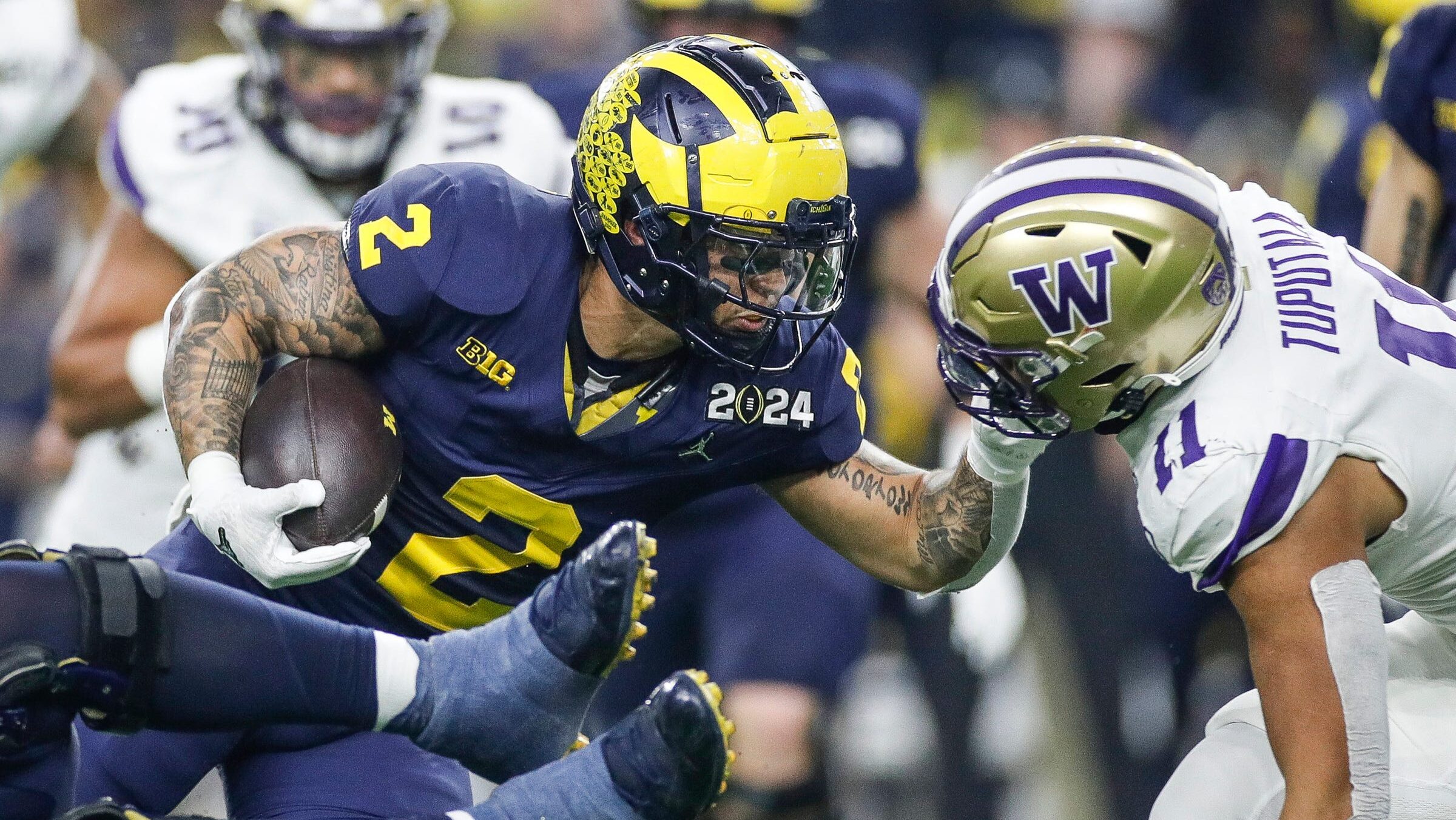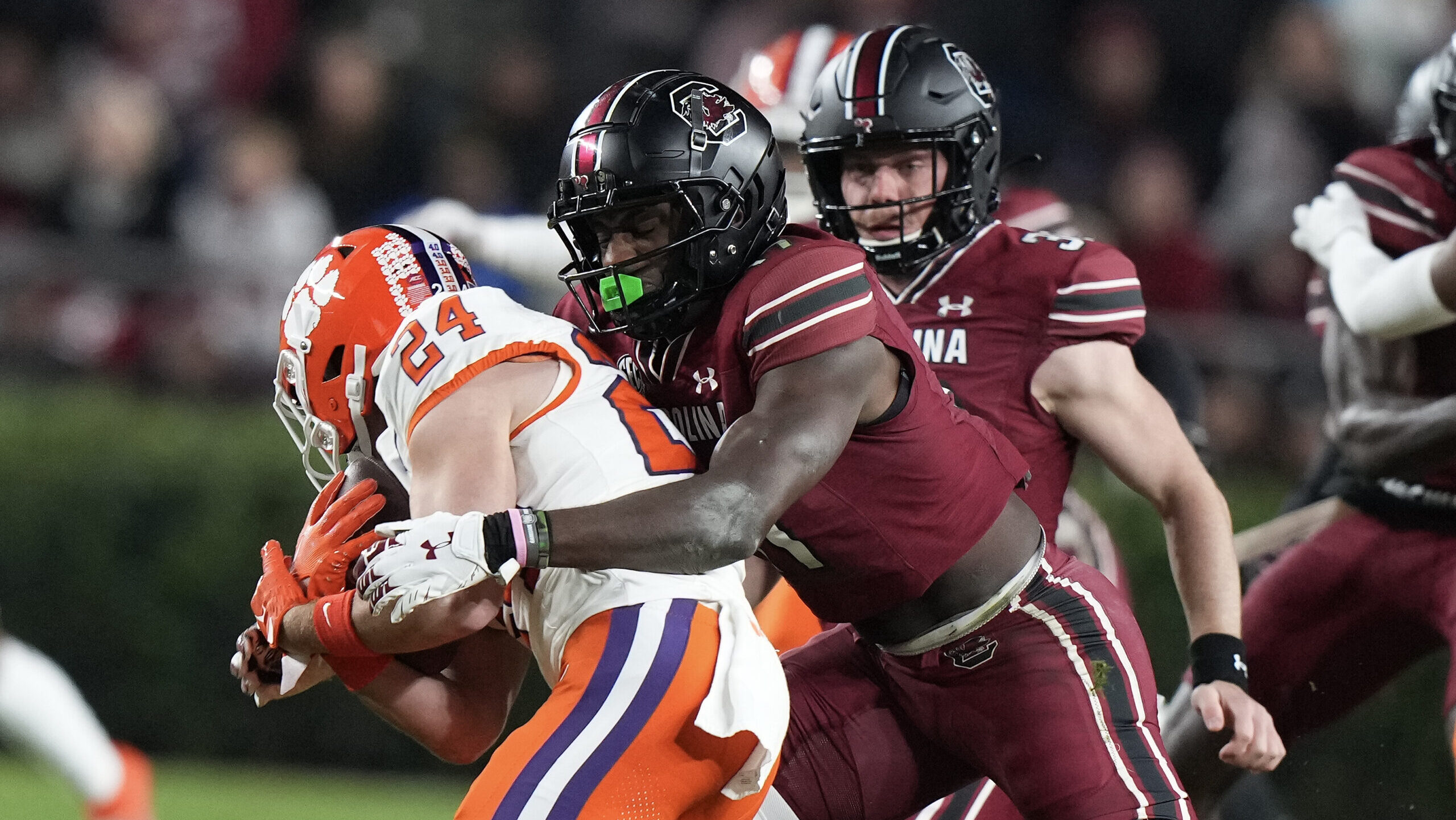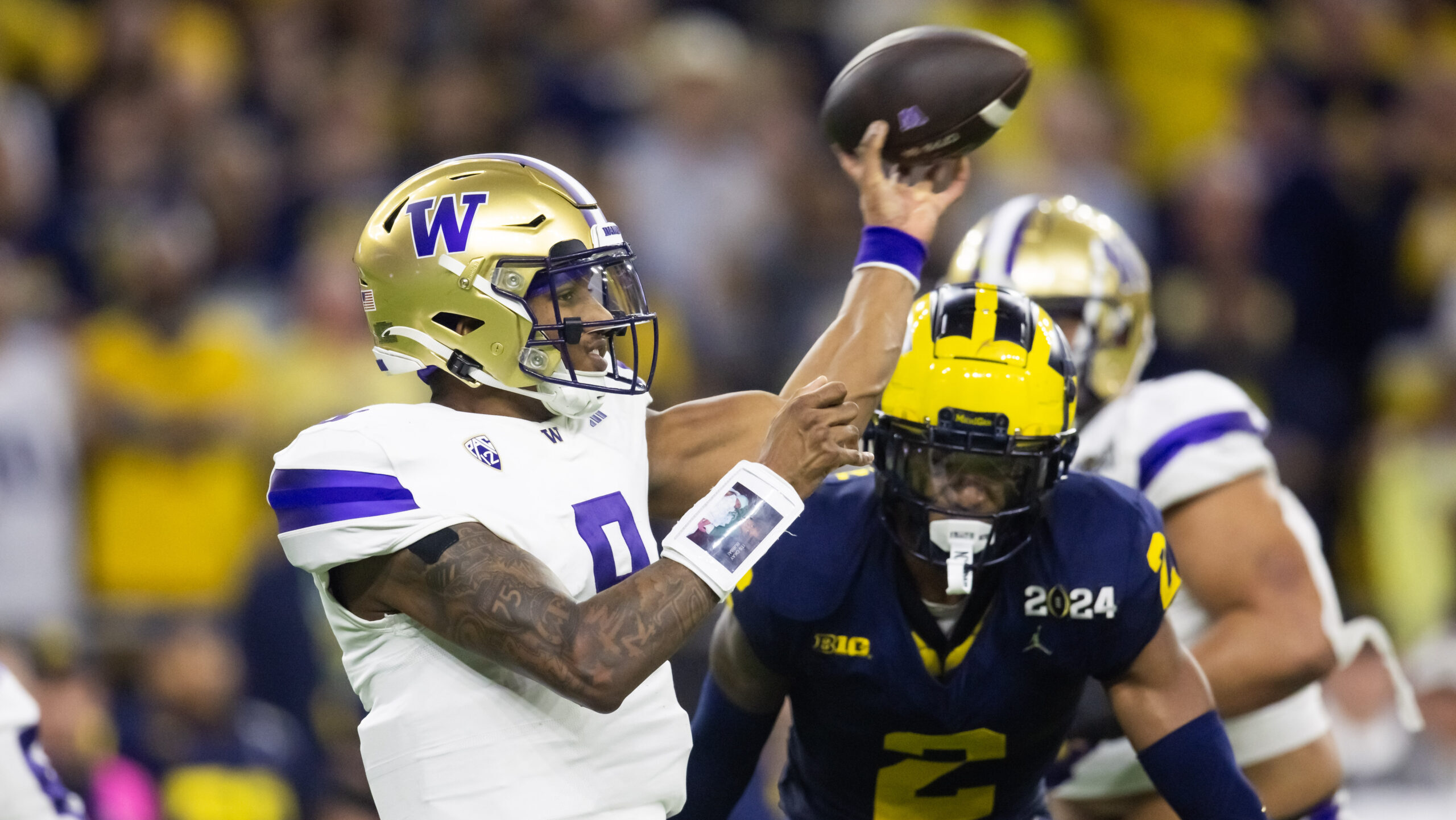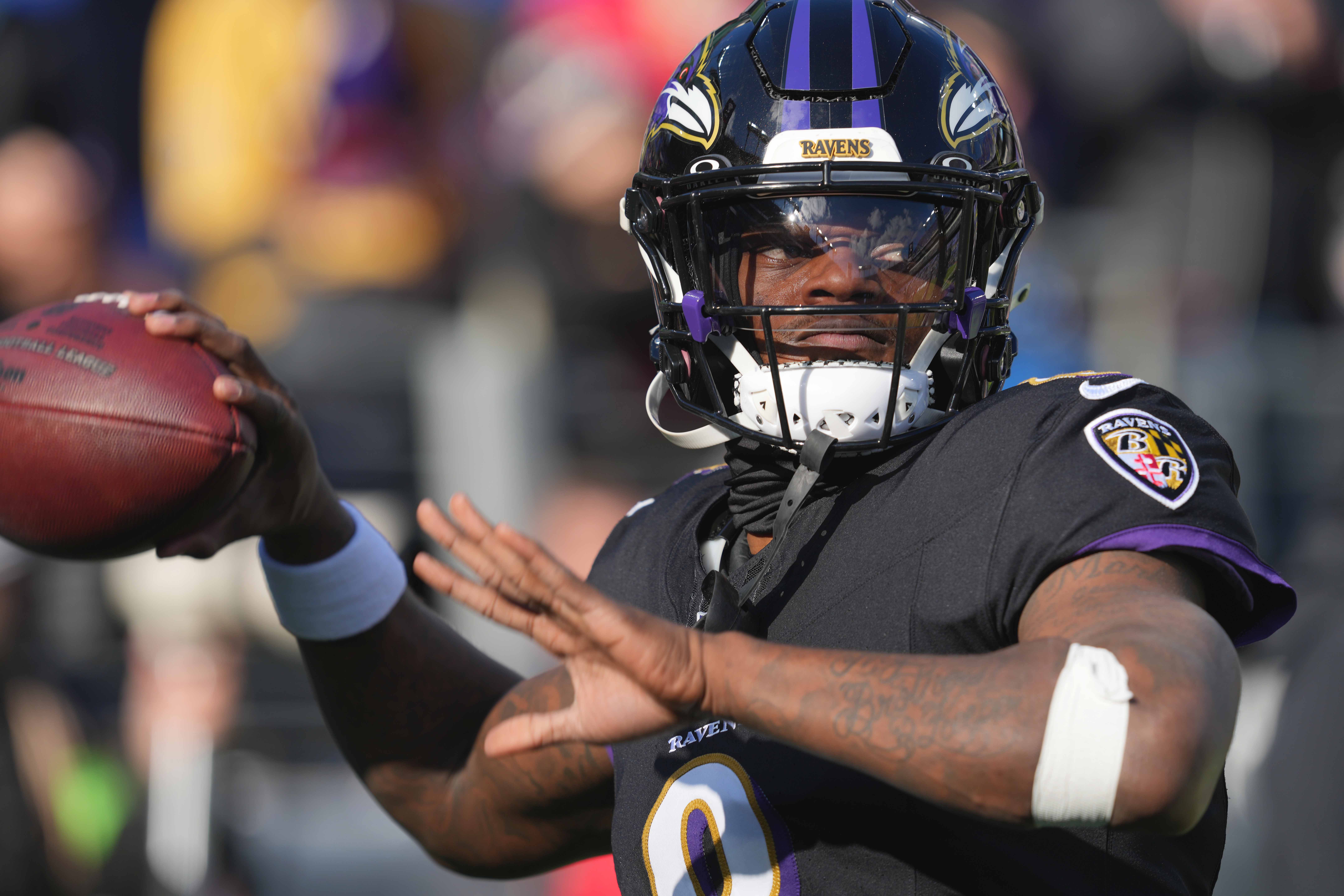Fantasy
7/27/23
11 min read
2023 Fantasy Football: Breaking Down 5 Big Gap Backfields
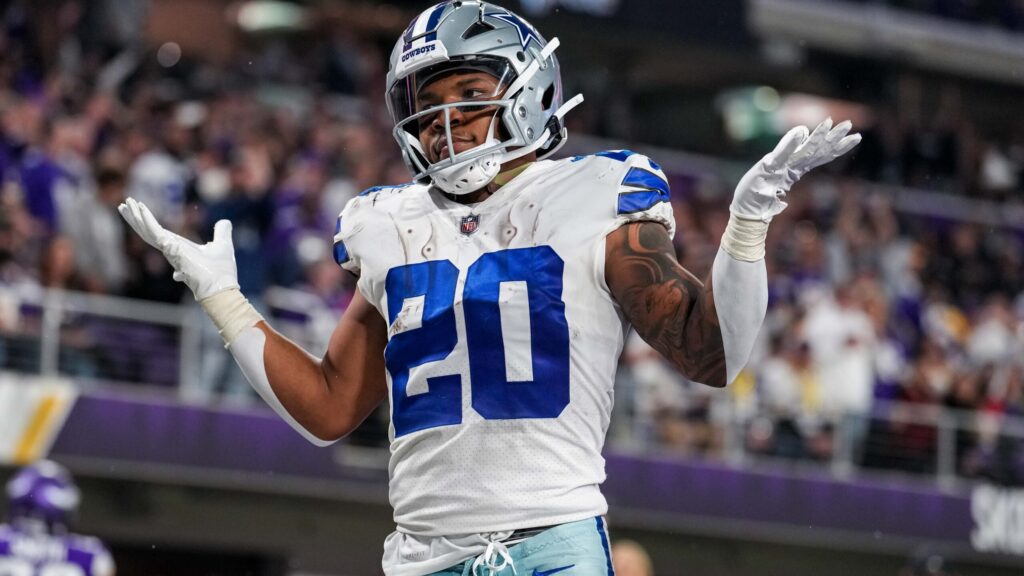
Last time, we examined the small and big gap running back research from 2021 and 2022. Using that information allows us to take a deeper look into the team- and player-level big gap backfields.
Using the recent Underdog average draft position (ADP), we have 18 teams with big gap backfields. We won’t analyze all 18 backfields, but we’ll touch on a handful.
As a review of terms, we’ll refer to the team’s first running back drafted in ADP as a B1 back and the second player as a B2 back. A big gap backfield entails two of the team’s top running backs with an ADP difference of 98.5 or higher.
We’ll consider the historical data while providing player-level information on how to play these big gap backfields.
Browns’, Cowboys’ Backfields
Nick Chubb, RB4, 13.8 ADP
Tony Pollard, RB7, 20.2 ADP
The Cleveland Browns and Dallas Cowboys usually have a small gap backfield, but this year, they have a big gap backfield. Kareem Hunt and Ezekiel Elliott used to share the load with their respective backs, causing a small gap in ADP.
In late July, Chubb and Pollard project to dominate the backfield share unless Elliott or Dalvin Cook put a wrench in the plans. Assuming the Browns and Cowboys’ backfields don’t add significant competition, Chubb and Pollard should have high win rates and fantasy production.
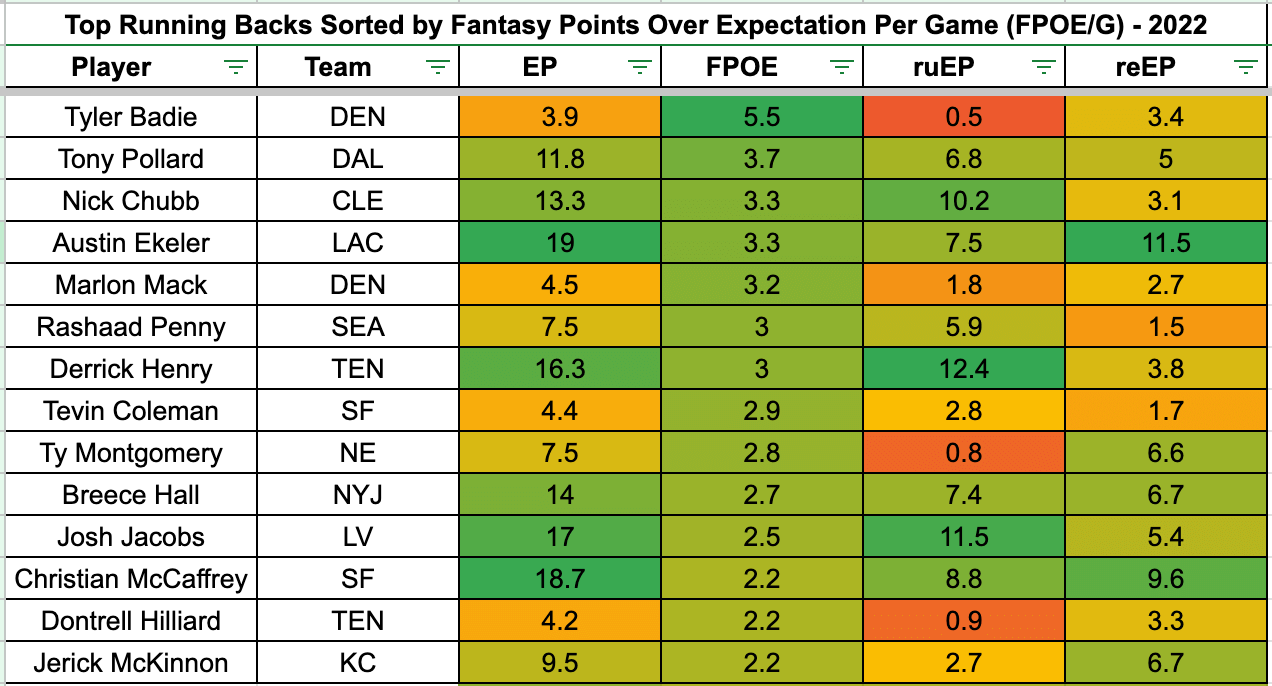
Though Chubb typically lacks receiving opportunities, as evidenced by his seven percent target share (2022), he produces efficiently. In 2022, Chubb averaged 13.3 expected points per game (EP/G), ranking 17th. However, Chubb ranked inside the top 10 in the efficiency metrics, with 3.3 fantasy points over expectation (FPOE/G), third among qualified backs.
Chubb averaged 2.6 receiving EP/G (No. 69) over the last two seasons, yet there’s a chance that increases in 2022 without Hunt.
Pollard boasts a more balanced profile, with 5.8 rushing EP/G and 4.8 receiving EP/G in 2021-22. That makes him more of a priority based on ADP vs. Chubb and fantasy scoring in PPR leagues. It wouldn’t surprise us if the Cowboys brought back Elliott, though Pollard truthers like myself don’t want that.
What About the B2 Backs?
Jerome Ford, RB52, 166.3 ADP
Malik Davis, RB70, 214.7 ADP
Deuce Vaughn, RB77, 215.5 ADP
Ronald Jones, RB 104, 216 ADP
Davis played five seasons at Florida and peaked with a 37 percent Running Back Dominator (RB Dom) as a freshman and a fifth-year player. Davis flashed a tiny bit of receiving skills, with a receiving yardage market share between seven and eight percent in his final two college seasons.
He contributed as the Cowboys’ RB3 in the latter half of the season, with decent advanced stats in the small sample.
Across 38 carries as a rookie, Davis averaged 1.6 yards before contact (YBC/Att), 2.7 yards after contact (YAC/Att) and an 11 percent broken plus missed tackle rate (BT+MT/Att). He probably won’t threaten Pollard from a receiving standpoint, though it’s plausible Dallas adds another running back.
Ford has garnered tons of buzz in the offseason as the B2 running back to Chubb with Hunt gone. After two seasons at Alabama, Ford moved to Cincinnati, with a peak season as a senior in 2021. Ford boasted a massive 71 percent RB Dom, with a respectable seven percent receiving yardage market share.
Last season, he struggled to make his way onto the field, ranking fourth on the team in snap share at 12 percent behind the top duo and Demetric Felton. Ford rocks above-average athleticism, with a Speed Score in the 76th percentile and a Freak Score in the 81st percentile. Having an athletic background helps with his fantasy chances.
Final Takeaways
Chubb and Pollard might finally have the backfield to themselves, with Pollard possessing the most upside as a balanced rusher and receiver. Last season, hitting on the correct B1 backs proved to be fruitful compared to big gap backfields in 2021.
In points per reception (PPR) formats, prioritize Pollard since he possesses the highest upside based on the receiving skills and opportunity. Don’t count out Chubb earning slightly more receiving opportunities.
Ford’s ADP keeps climbing near somewhat proven players, including Donovan Peoples-Jones, D’Onta Foreman, Kenneth Gainwell and Raheem Mostert. Given Ford’s college profile, he deserves the edge in ADP vs. Davis.
Davis lands as the B2 back for the Cowboys, with Vaughn and Jones close behind by about two picks on average. We covered Vaughn’s profile and how he might defy the prototypical running back size arguments earlier this offseason.
Vaughn theoretically holds an edge on Davis in the receiving game, with Jones more as an early down grinder to cover Davis. With the small NFL samples, it’s hard to confidently suggest any Browns or Cowboys B2 backs.
Rams’ Big Gap Backfield
Cam Akers, RB21, 65.7 ADP
Zach Evans, RB74, 215.4 ADP
Akers goes as RB21 in Underdog leagues, yet Evans’ ADP sits nearly 150 picks later. Akers attempts to defy the odds as a running back hoping to return to fantasy relevance from an Achilles injury.
From Weeks 13-18, Akers averaged the sixth-most fantasy points, with 18 PPR/G behind Derrick Henry. Akers ranked fifth in FPOE/G during that stretch, indicating high efficiency, partly due to the six touchdowns after one in his first nine weeks.
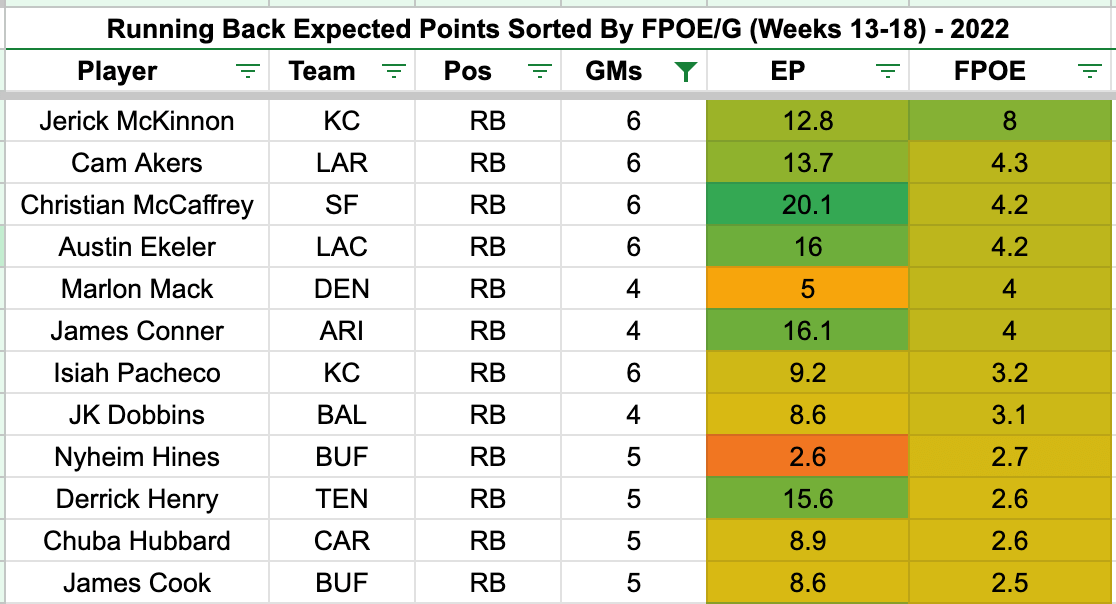
He also added receiving work, with a two percent target share in eight active games in Weeks 1-11 vs. six percent in Weeks 12-17. That coincided with Cooper Kupp and Matthew Stafford’s injury.
Akers averaged 6.8 PPR with Kupp and 14.5 without him, though most of the volume came via the ground (10.6 vs. 16.8 rush attempts per game).
We covered Evans as one of the running backs projected to go in Rounds 3-4, with top comparisons of Devonta Freeman, Anthony McFarland and Travis Homer.
In college, Evans created yards after contact and evaded tacklers well. Akers ranked 30th in yards after contact per attempt (YAC/Att). However, Akers struggled to create yards before contact with 1.40 YBC/Att (No. 27). That could be an issue for Evans when he earns a chance, but it’s a similar profile to Akers’.
Final Takeaways
The Rams ranked 24th in Offensive Total EPA/G at -3.89 after being fifth-best in 2021 (5.17). Their pass rate remained relatively the same in the past two seasons, with 61 percent (2021) and 60 percent (2020).
Without Stafford from Weeks 12-17, the Rams’ pass rate fell to 52 percent (No. 24), and they had the 11th-highest rush rate (48 percent). The team had a slower pace without Stafford, evidenced by the second-lowest plays per game without him in Weeks 12-17. That fell from 64 plays per game (No. 19) in Weeks 1-11.
Stafford’s health and efficiency will have an impact on the offense’s effectiveness. Though history suggests targeting Akers, the weaker projected offense might warrant fading Akers in favor of Evans in the later rounds.
Buccaneers' Backfield
Rachaad White, RB25, 81.4 ADP
Sean Tucker, RB81, 215.7 ADP
Ke’Shawn Vaughn, RB86, 215.9 ADP
Chase Edmonds, RB 87, 215.9 ADP
After much buzz around White’s elite 22 percent receiving yardage market share in his final season at Arizona State, he projects to have the lead role for the Tampa Bay Buccaneers.
With Leonard Fournette gone, White becomes a big gap running back in 2023 with Edmonds as the veteran B2. Last season, Fournette dominated the touches. He had a 52 percent rush share (Rush%) and a 12 percent target share. Meanwhile, White only garnered a 33 percent rush share and an eight percent share of the targets.
There’s no denying Fournette struggled with efficiency, evidenced by the -0.8 fantasy points over expectation (FPOE/G), ranking 116th. The expected points (EP) of 14.9 (No. 10) in 2022 and 17 (No. 5) in 2021 indicate Fournette earning a balanced role as a rusher and receiver with high-value touches.
We witnessed the potential for White to receive a healthy share of the opportunities, especially as a receiver from Week 12-17.
White’s Receiving Uptick
White averaged a 12 percent target share (No. 17), with Fournette at 14 percent (No. 11) during that six-game stretch. The EP data aligns with Fournette averaging 15.5 EP/G (No. 8) and White at 13.2 (No. 15). Fournette ranked fourth in receiving EP/G (9.6) with White at eighth (8.0) during Weeks 12-17.
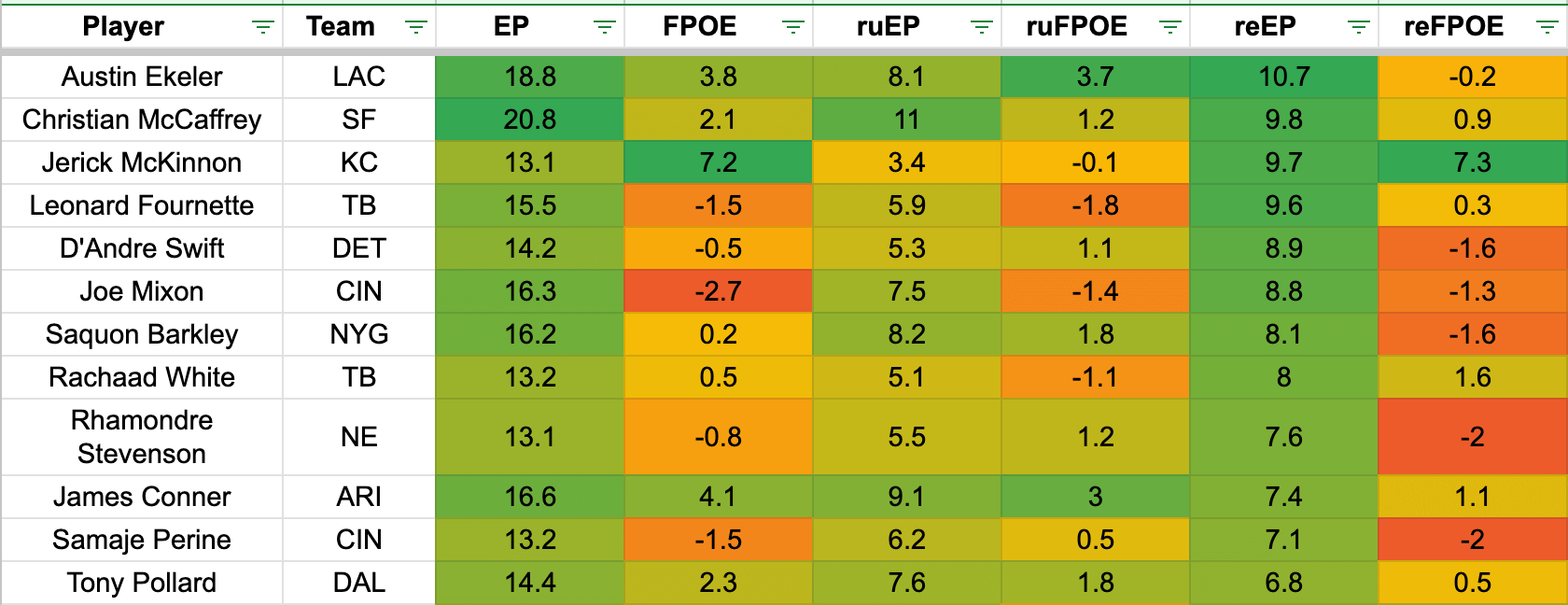
It’s safe to expect a dip in volume and efficiency without Tom Brady at quarterback and with Baker Mayfield taking his place. In 2022, the Buccaneers ranked first in pass rate (67 percent), plays per game (71) and pace in seconds per snap (23.8).
That’s a small sample, but with Mayfield on the Rams, they averaged a 54 percent pass percentage (No. 23), 55 plays per game (No. 32) and 29.7 seconds per snap (No. 29) during Weeks 14-18.
Final Takeaways
We learn from our mistakes, and Edmonds, one of my top ZeroRB targets, is one of them. Edmonds gave us three weeks with double-digit fantasy points, though it came with two different teams. His advanced metrics improved with the Denver Broncos via yards before contact (1.4 vs. 2.2), yards after contact (1.4 vs. 2.7) and broken plus missed tackle rate (two percent vs. 19 percent).
The recency bias of Edmonds put a bad taste in the mouths of fantasy managers, and rightfully so. Now, Edmonds lands as the B2 running back behind White.
We already saw signs of the Buccaneers’ offense declining from an EPA standpoint, given their -2.97 Offensive EPA/G (No. 22) in 2022 after the third-best (7.19) in 2021. White should have a high amount of high-value touches in his favor. Fournette ranked second last season behind Austin Ekeler.
The Underdog ADP for White puts him in a range of D’Andre Swift, David Montgomery and James Conner. Swift possesses the most upside, but White arguably garners a receiving role similar to Swift. History tells us if we land on the correct B1 back, it will lead to quality fantasy production and win rates.
We’re slowly warming up to White, especially as a ZeroRB option. When the big gap backfield ADP was pulled, Edmonds landed as the B2 back. It has since shifted slightly to include Tucker and Ke’Shawn Vaughn. The market indicates it’s a dart throw on choosing a B2 back in Tampa Bay.
Falcons' Backfield
Bijan Robinson, RB3, 9.6 ADP
Tyler Allgeier, RB46, 143.9 ADP
Cordarrelle Patterson, RB64, 204.2 ADP
After a relatively strong season from Allgeier, as the team established the run and frustrated fantasy managers, the Atlanta Falcons drafted Robinson. The former Longhorns running back dominated as a rusher and receiver.
Robinson is a well-rounded B1 back, ranking sixth among college running backs in yards per route run. He flashed efficiency as a receiver, averaging 10.1 yards per target (YPT), tying him for first (minimum 25 targets).
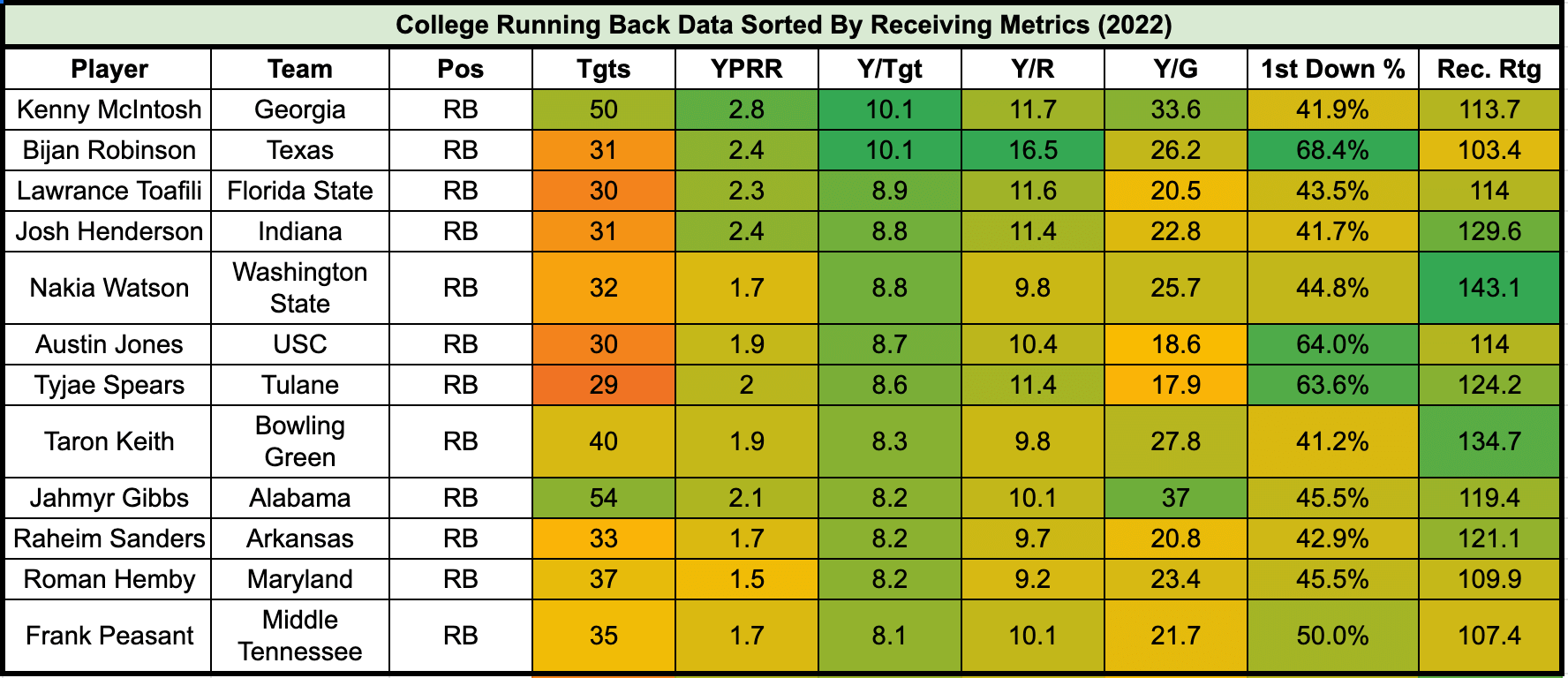
In college, Robinson ranked 12th in YAC/Att and fifth in broken plus missed tackles per attempt (BT+MT/Att), with a minimum of 50 carries.
We loved Allgeier’s tough running as a rookie, evidenced by the sixth-best BT+MT/Att (25.2 percent) and third-highest YAC/Att (3.4). Allgeier avoided negative plays. He had the 15th-best stuff rate, indicating that 13.8 percent of his runs resulted in zero or fewer yards.
Will the Falcons Keep Establishing the Run in 2023?
Last season, the Falcons had the biggest dip in targets per game to their running backs of -4.3. That aligns with the second-highest rush rate at 54 percent and the second-worst pass rate (46 percent). They averaged 61 plays per game (No. 28) with the fifth-slowest pace of play at 28.2 seconds per snap.
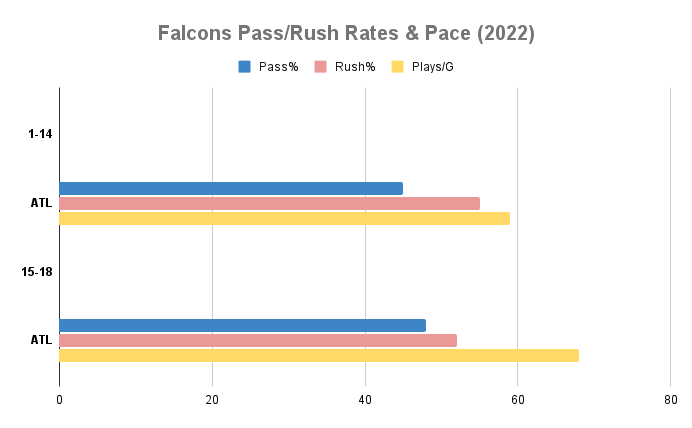
When Desmond Ridder took over in Weeks 15-18, the Falcons still established the run but ran more plays per game. During those four weeks, the Falcons ranked third in Rush% (52 percent) and 28th in Pass% (48 percent).
Their pace improved slightly to 27.8 seconds per snap, averaging the ninth-most plays per game (68) in Weeks 14-18.
We lay all that out to understand the potential range of outcomes with the Falcons’ offense and whether Robinson will live up to his ADP as a big gap running back.
Before Ridder took over, they targeted the running backs 2.8 times per game. That increased to 6.8 running back targets per game in Weeks 14-18, which bodes well for Robinson’s fantasy value, though it's a small, four-game sample.
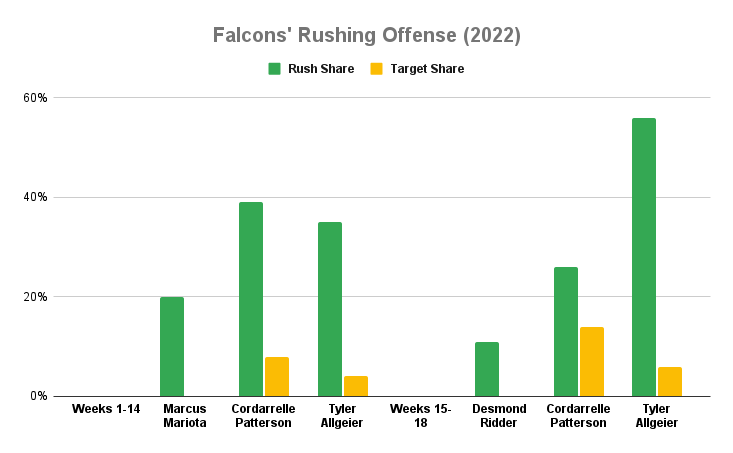
We’ll note Patterson garnered most of the receiving opportunities in the backfield with a 14 percent target share (Weeks 15-18). Meanwhile, Allgeier averaged a six percent share during the final four weeks. For context, Patterson’s target share increased by six percentage points, and Allgeier’s increased by two points compared with Weeks 1-14.
Final Takeaways
Five running backs drafted in the top 10 averaged more than 10 PPR/G as a rookie during the past 10 seasons. That includes Saquon Barkley, Elliott, Christian McCaffrey, Fournette and Todd Gurley.
When we stretch that to the first round, the list grows to Najee Harris, Clyde Edwards-Helaire, Josh Jacobs, Sony Michel, Melvin Gordon and Rashaad Penny. Patterson popped up, too, but his rookie production came as a wide receiver.
Robinson likely falls into the group drafted in the top 10 picks. Maybe Arthur Smith found the next Henry with receiving skills in Robinson. Assuming the offense takes a step forward with a slightly lower rush and higher pass rates, plus a better pace, Robinson possesses the talent worthy of a first-round selection in redraft formats.
Make sure to select Allgeier in the later rounds. Or consider Patterson because the Falcons’ backfield should be fruitful as a deep-league option.
Follow The 33rd Team Podcast Network on Spotify and Apple Podcasts.

